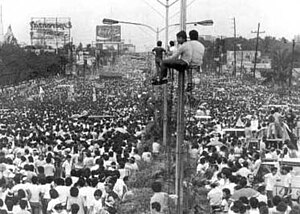People Power Revolution of 1986
| People Power Revolution | |||
|---|---|---|---|
 |
|||
| Date | February 22—25, 1986 (3 days) |
||
| Location | Philippines, primarily Epifanio de los Santos Avenue, Metro Manila | ||
| Caused by |
|
||
| Goals | Removal of Ferdinand Marcos from office to put Corazon Aquino as the President |
||
| Resulted in |
Revolutionary victory
|
||
| Parties to the civil conflict | |||
|
|||
| Lead figures | |||
|
|
|||
| Number | |||
|
|||
Revolutionary victory
![]() People Power Revolutionaries
People Power Revolutionaries
Political groups:
Military defectors:
Others:
Religious groups:
Militant groups:
Government Parties:
The People Power Revolution (also known as the EDSA Revolution and the Philippine Revolution of 1986) was a series of popular demonstrations in the Philippines, mostly in the capital city of Manila from February 22–25, 1986. There was a sustained campaign of civil resistance against regime violence and alleged electoral fraud. The nonviolent revolution led to the departure of President Ferdinand Marcos along with his totalitarian regime and the restoration of democracy in the Philippines.
It is also referred to as the Yellow Revolution due to the presence of yellow ribbons during the demonstrations following the assassination of Filipino senator Benigno "Ninoy" Aquino, Jr. in 1983. It was widely seen as a victory of the people against the 20-year running authoritarian, repressive regime of then president Ferdinand Marcos, and made news headlines as "the revolution that surprised the world".
...
Wikipedia
